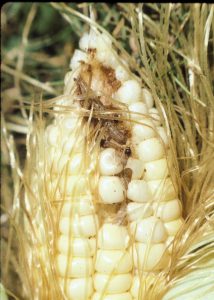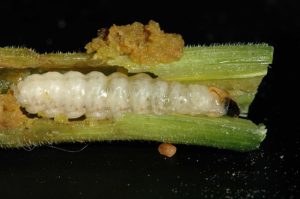Sweet Corn IPM Newsletter No. 3 — June 28, 2024
CORN BORER AND EARWORM THREATEN SILKING CORN!
Spotted Wing Drosophila Active in Strawberry Fields
SITUATION
Early planted corn is in the tassel to early silk stage in southern Maine. Most fields have had adequate water, although a few farms have been irrigating. We again caught all three of the major sweet corn pests in pheromone traps this week, so growers with silking corn should be spraying to protect against infestation. Growers should also be on the alert for feeding injury in the fields with whorl to pre-tassel stage corn.

European corn borer: Moth counts continue to be fairly high this week, bringing a threat to any fields in the silking stage. Moths were over threshold for silking corn in Dayton and Farmington, where corn earworm was not over threshold, so sprays to silking corn were recommended at those sites. We have now found larval feeding in late whorl and pre-tassel corn at all of our locations, but only one site was over the recommended spray threshold of 15% injury this week.
Corn earworm: Moths were caught in pheromone traps at most of our sites this week, but numbers are still fairly low, and most fields are not yet at the silking stage. When corn earworm moths are caught at a site, all silking corn in the fields should be protected with regular sprays, following the recommended intervals in the table below. This week a five-day spray interval was recommended for our site in Lewiston, where we caught four earworm moths and silking corn was present.
Fall armyworm: We continue to catch a few fall armyworm moths in pheromone traps, but not yet in high enough numbers to present a direct threat to any silking corn. We also found the first fall armyworm larvae of the season this week, feeding on pre-tassel corn. The larvae chew large, ragged holes in corn leaves, and leave lots of sawdust-like waste around the emerging tassels. When this injury is found, it is combined with any European corn borer injury found and a threshold of 15% of plants with fresh injury is used to determine if a spray should be applied.

Squash vine borer: We are catching squash vine borer moths in pheromone traps in southern Maine. One location in Wells was well over the threshold of 5 moths caught per week. Squash vine borers will attack most summer squash, pumpkins and winter squash. They do not affect cucumbers or butternut squash. Growers should be on the lookout for damage on squash and pumpkin plants. See the New England Vegetable Management Guide for control options.
Spotted Wing Drosophila Alert! Strawberry growers in southern Maine have been finding spotted wing drosophila fruit flies and larvae in ripe strawberry fruit. This is very early activity for this pest in Maine. Although it does overwinter here, numbers do not typically get high enough to impact fruit crops until mid-late August. Growers who still have a good crop of strawberries to harvest should be on the lookout for this pest and begin a spray regime if it is found. Growers with any ripening raspberries or blueberries should begin a management program now. For more information visit our Spotted Wing Drosophila blog.
Sincerely,
David T. Handley
Vegetable & Small Fruit Specialist
Highmoor Farm
P.O. Box 179
52 U.S. Route 202
Monmouth, ME 04259
207.933.2100
UMaine Extension Diagnostic Research Lab
Pest Management Unit
17 Godfrey Drive
Orono, ME 04473
1.800.287.0279
| Location | CEW Moths | ECB Moths | FAW Moths | %Feeding Damage | Recommendations / Comments |
|---|---|---|---|---|---|
| Biddeford | 0 | 7 | 0 | 21% | 1 spray for ECB feeding on pre-tassel corn |
| Bowdoinham | 1 | 2 | 0 | 10% | No spray recommended (no silking corn) |
| Cape Elizabeth | 6 | 9 | 0 | 11% | No spray recommended (no silking corn) |
| Dayton | 1 | 9 | 1 | 1% | 1 spray for ECB feeding on silking corn |
| Farmington | 0 | 8 | 0 | 16% | 1 spray for ECB feeding on silking and pre-tassel corn |
| Gray | 0 | 0 | 0 | 5% | No spray recommended |
| Lewiston | 4 | 1 | 0 | 5% | 5-day spray interval for silking corn |
| Lewiston II | 1 | 19 | 0 | 4% | No spray recommended (no silking corn) |
| Oxford | 0 | 5 | 0 | 11% | No spray recommended (no silking corn) |
| Wayne | 1 | 15 | 0 | 3% | No spray recommended (no silking corn) |
| Wells I | 3 | 11 | 2 | 14% | No spray recommended (no silking corn) |
| Wells II | 0 | 6 | 0 | 7% | No spray recommended (no silking corn) |
CEW: Corn earworm (Only fresh silking corn should be sprayed for this insect.)
ECB: European corn borer
FAW: Fall armyworm
| Moths caught per week | Moths caught per night | Spray Interval |
|---|---|---|
| 0.0 to 1.4 | 0.0 to 0.2 | No spray |
| 1.5 to 3.5 | 0.3 to 0.5 | Spray every 6 days |
| 3.6 to 7.0 | 0.6 to 1.0 | Spray every 5 days |
| 7.1 to 91 | 1.1 to 13.0 | Spray every 4 days |
| More than 91 | More than 13 | Spray every 3 days |
Thresholds apply only to corn with exposed fresh silk. Lengthen spray intervals by one day if maximum daily temperature is less than 80°F.
European Corn Borer Thresholds
Whorl stage: 30% or more of plants scouted show injury.
Pre-tassel-silk: 15% or more of plants scouted show injury.
Silk: 5 or more moths caught in pheromone traps in one week.
IPM Web Pages:
Explore Integrated Pest Management in Maine — UMaine
Integrated Pest Management Data Visualization Tool — Penn State
Integrated Pest Management — UMass Amherst
Where brand names or company names are used, it is for the reader’s information. No endorsement is implied nor is any discrimination intended against other products with similar ingredients. Always consult product labels for rates, application instructions and safety precautions. Users of these products assume all associated risks.
In complying with the letter and spirit of applicable laws and pursuing its own goals of diversity, the University of Maine System does not discriminate on the grounds of race, color, religion, sex, sexual orientation, transgender status, gender, gender identity or expression, ethnicity, national origin, citizenship status, familial status, ancestry, age, disability physical or mental, genetic information, or veterans or military status in employment, education, and all other programs and activities. The University provides reasonable accommodations to qualified individuals with disabilities upon request. The following person has been designated to handle inquiries regarding non-discrimination policies: Director of Equal Opportunity, 5713 Chadbourne Hall, Room 412, University of Maine, Orono, ME 04469-5713, 207.581.1226, TTY 711 (Maine Relay System).
